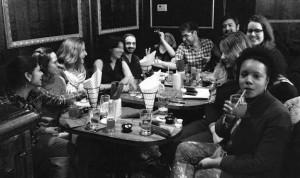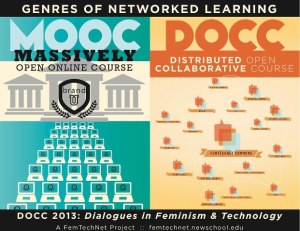FemTechNet Roadshow Blog Series* – Distributed
by Maria-Belén Ordóñez, OCAD University Toronto, Canada
A version of this paper was presented at the Feminist Pedagogy Conference 2015: Transformations on April 17, 2015 at the CUNY Graduate Centre in New York City.
Unlike the MOOC, the point of the DOCC has never been to reach masses, but rather to build collaborations across and between institutions and organizations and to build a network of feminists who are committed to inclusive, democratic learning. MOOC Instructors are at a single institution where their expertise is “branded” and centralized in terms of structure, access, and participation. Unlike the DOCC, the MOOC is scripted with fewer opportunities to make changes, shift learning directions, or engage the world outside an online experience. The learning formula of MOOC reflects the corporatization of post secondary education, which has made it increasingly difficult for educators to advocate for accessible education and for more democratic learning environments. The one-teacher model of the MOOC acts as if there is only a single purveyor of knowledge who can’t be interrupted or questioned because MOOC learners are receivers and not active participants in their own learning. However, connective learning experiences happen when Other perspectives, geographies, corporealities and subjectivities become key components in challenging static narratives. To this end, the DOCC disrupts origins by disseminating pedagogical resources that come from everywhere and must therefore go everywhere.
In contrast to this, I’ve come to observe the MOOC as a peculiar commitment to Oedipal structures whereby everything leads back to a profit driven institution that is centralized, hierarchal, and origin based. Like an oedipal structure, the MOOC’s purpose is to keep knowledge in the normative-institutional family.
The DOCC on the other hand, interrogates what Jack Halberstam sees as “Oedipal models of generationality” that faithfully disseminate knowledge between the symbolic and essentialist bond of “mother-daughter”(Halberstam, J. 2011:124). Oedipal models don’t rupture the stasis of essentialist claims, for example, nor do they undo the hierarchy of teacher-student relationships because contrary to movement, Oedipal models rely on fixed and predictable points of exchange.
Celebratory completion of DOCC course at OCADU, Toronto Ontario. April, 2015 (with permission).
The break from “Oedipal models of generationality” can be observed as “counterintuitive feminism” which Halberstam argues derives from a “queer, postcolonial, and black feminism that thinks in terms of negation of the subject rather than her formation, the disruption of lineage rather than its continuation, the undoing of self rather than its activation” (ibid). Halberstam points to a classic example of “counterintuitive feminism” in Yoko Ono’s 1965 performance, “Cut Piece”. Here, Yoko Ono invites her mainly male audience to cut a piece of her clothing with a pair of scissors and she doesn’t influence what they cut or how much they cut. In Halberstam’s words, “Ono stages her own vulnerability…” (p.138). Thinking alongside a “counterintuitive feminism,” a distributed pedagogy creates paths of communication by fostering cross-class interactions despite the sometimes tenuous milieus of online misogyny. The value is no longer located in promoting the expertise of one institution and one instructor, instead, value derives from varied sites of collaboration and tension which contribute to feminist discourses about what patriarchy means and does in specified cultural contexts.
Halberstam credits some of this necessary disruption to postcolonial critiques, which demand a decolonization of precarity, feminism, oppression and justice. Specifically, Halberstam thinks with Gayatri Spivak’s well known essay, “Can the Subalteran Speak ?” (1988) which critically observes a Western feminist logic that has been (and continues to be) committed to colonial formulations of “saving” Other women. In this instance, oppression is universally knowable and identifiable through a supposedly clear set of desired (liberal) rights. These efforts to “save women” from their own oppression is so absolute that not seeing oppression as defined by some feminists presumably contributes to (self) oppression. Thus, other feminist logics are invalidated in their claim and/or disclaims for autonomy, desire, freedom and (non)subjectivity.
“Distributed” in this context and in the DOCC renders the nuances of embodied experiences, making it difficult to claim an overarching and singular feminist project or source of oppression. This is particularly evident in the production of keyword videos and dialogues that are not bound by a central organizing unit; instead, any FemTechNet participant can share and contribute to the cacophony of voices. This may be organized in terms of a cross-class assignment where students are asked to respond or comment. It may also exist in the network itself, where material can be accessed and discussions initiated and generated in numerous locations.
Another influential “distributed path” for me in the DOCC is Donna Haraway’s classic 1985 essay, “A Manifesto for Cyborgs” which highlights the importance of being unfaithful to origins, specifically those associated with goddess feminism. Haraway’s cyborgs of the late 80s were the “illegitimate offspring of militarism and patriarchal capitalism” (1990:193). Today’s cyborgs are also illegitimate offspring of Western feminism and true to Haraway’s conceptualizations, cyborgs must navigate in the in-between spaces of an informatics of domination. No longer faithful to either the mother or the father, both are inessential to constructing new concepts. No longer tied to a specific disciplinary order, feminist pedagogies in the DOCC activate tools for staying alive where what matters is the right to do rather than the right to consumption.
In Gilles Deleuze’ essay, “What Children Say” (1997) the idea of movement and creation is further elaborated upon in the concept of a milieu. Deleuze sees milieus everywhere as sources of engagement. He argues that: “Parents are a milieu that children travel through: they pass through its qualities and powers and make a map of them” (ibid:1). But children are not limited to the milieus of their parents.
Likewise, participants in the DOCC are not limited to the milieus of instructors and it is the ongoing contributions and participation that effectively multiply feminist networks. Teaching the DOCC (for me) includes asking, what are the maps we create in conceptualizing the world as we’d like to imagine it, and at the same time, move in it ? How might this include queer non-conforming genders who are always becoming in new and (im)possible milieus?
A brief but relevant example as to how I observed this in the most recent DOCC at OCAD University in Toronto, was in a cross-class assignment with Dr. Karen Keifer Boyd at Penn State University and her DOCC class. As a general introduction between classes, Dr. Keifer Boyd and I arranged for students to meet online through a selected course reading. We did this as an exercise of embodied theorizing, which entailed communicating a selected moment/event in a student’s life in conjunction with the theoretical threads of the assigned reading. It was a way to divert students from presenting classic “shopping list” introductions that tend to fall in line with a narrative of identity politics. True to a DOCC (anti) structure we were not limited by a specified style of presentation—we didn’t have to use the same reading, nor did we have to use the same format for both classes. What mattered was the online space that we created for the exchange of ideas between institutions and disciplines. At OCADU students uploaded their introductions on Sound Cloud (as sound performances), Dr. Boyd’s class presented their introductions as “identity maps” (in drawing and text) online.
These mediums of text and technology facilitated student’s exchange and also actively engaged with Erin Manning’s politics of touch and Allison Weir’s ideas of global solidarity and transformation. Students then had the opportunity to respond and comment on each other’s introductions. With permission, I include DOCC participant Theresa Slater’s sound cloud introduction here . For students in my class, the recording of their voice without the visual was an experiment that resulted in powerful narratives that connected aspects of their lives with the practice of “reaching towards” difference. We initiated the course by designing relation-scapes with another DOCC class, not in order to relay summaries of what was read, but rather, as an exercise of mediating the potential impacts of an “introduction” of self as fluid and becoming. This kind of “Distributed” is unfaithful to institutional origins as much as it is unfaithful to conceptualizations of essentialist identities. These are different flows of desire that have not been reduced to Oedipal codes (Deleuze, 2004) whereby reading an assigned text requires learning an inscribed interpretation generated by an expert. Instead, resonance was given value in reflecting on why and how students might communicate both in our specific courses as well as with each other.
It is important to acknowledge the struggles that may come with movement and with the idea of distributed in institutions that don’t operate this way. It is relevant therefore to incorporate and track how these struggles impact different realms of our lives. The internal logic of an institution, for example, will not move at the same pace as those in distributed networks. Meanwhile FemTechNet keeps moving and continues to meet but not for the purpose of settling (down) or keeping things as they are. Distributed knowledges in the DOCC motivate the creation of new concepts for living, loving and resisting.
References Cited:
Deleuze, Gilles. (1997). “What Children Say” https://16beavergroup.org/articles/2008/01/24/rene-deleuze-what-children-say/ (accessed April 13, 2015).
Deleuze, Gilles and Felix Guattari. (2004). Anti-Oedipus: Capitalism and Schizophrenia. London: Continuum.
Halberstam, J. (2011). “Shadow Feminisms: Queer Negativity and Radical Passivity.” Queer Art of Failure. Durham: Duke University Press. pp.123-146.
Haraway, Donna. (1990). “A Manifesto for Cyborgs: Science, Technology, and Socialist Feminism in the 1980s.” Feminism/Postmodernism. New York: Routledge. pp.190-233.
Sandoval, Chela. (2000). “U.S. Third World Feminism- Differential Social Movement I.” Methodology of the Oppressed. Minneapolis: University of Minnesota Press. pp.40-63.
Spivak, Gayatri. (1988). “Can the Subaltern Speak?” https://www.maldura.unipd.it/dllags/docentianglo/materiali_oboe_lm/2581_001.pdf (accessed April 12, 2015)
*FemTechNet Roadshow Blog Series
Over the past couple of months, about a dozen FemTechNet participants have presented work based on our research and teaching related to FemTechNet in a two-part FemTechNet Keywords Workshop at the CUNY Feminist Pedagogies Conference in April 2015, and at the Union for Democratic Communications Conference at the University of Toronto in May 2015. Since these gatherings brought together such divergent modes of FemTechNet engagement, we thought we’d collect and share this new work over the last two weeks of May, leading up to the deadline for our 2015 FTN Summer Workshop. For more information on this series, contact T.L. Cowan

